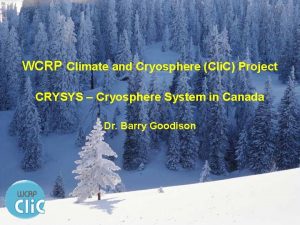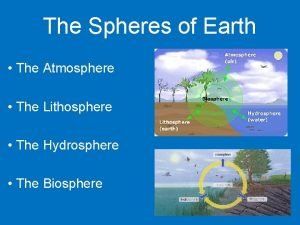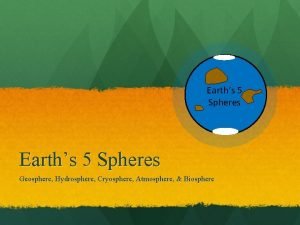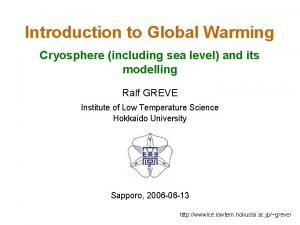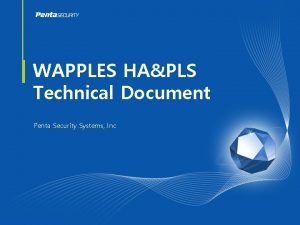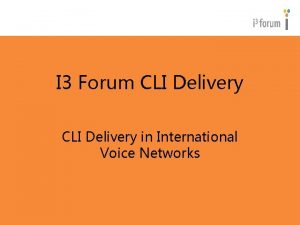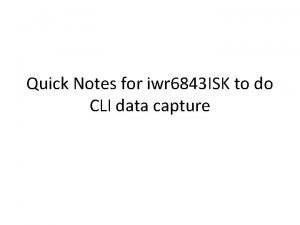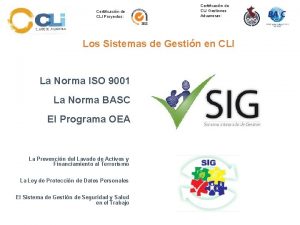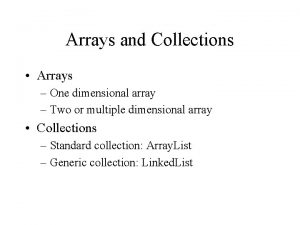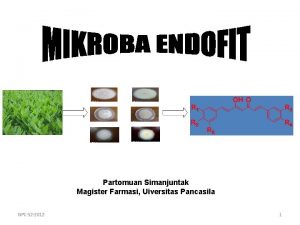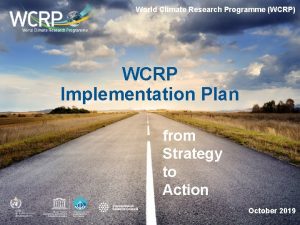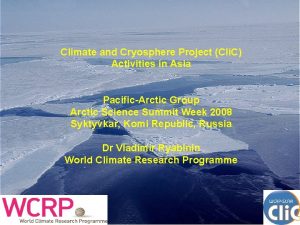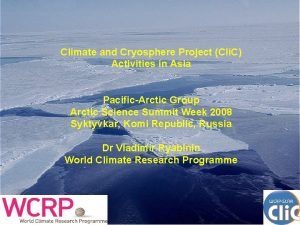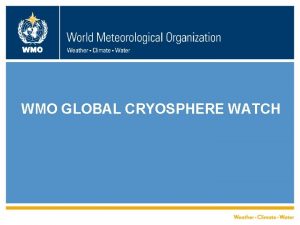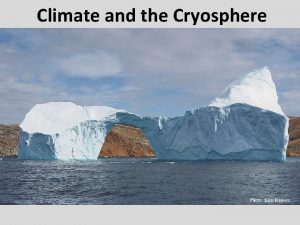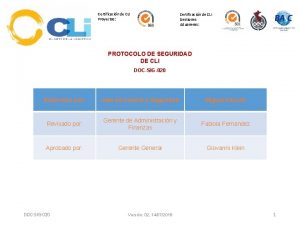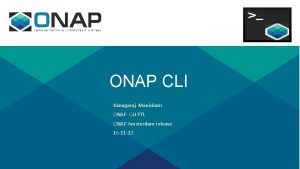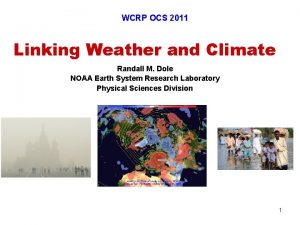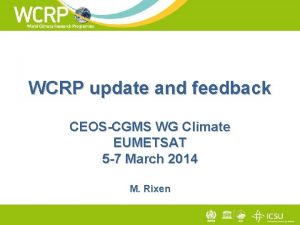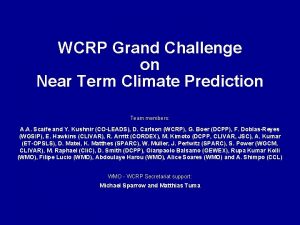WCRP Climate and Cryosphere Cli C Project CRYSYS




















- Slides: 20

WCRP Climate and Cryosphere (Cli. C) Project CRYSYS – Cryosphere System in Canada Dr. Barry Goodison

CLIVAR 1995 ACSYS/Cli. C 1994– 2003/2000 WGNE WGCM WGSF WOCE 1990 -2002 TOGA 1985 -1994 GEWEX 1988 SOLAS 2001 -> SPARC 1992

Cli. C Goal and Objectives Principal Goal: Assess and quantify the impacts that climatic variability and change have on components of the cryosphere and the consequences of these impacts for the climate system, and to determine the stability of the global cryosphere Supporting Objectives: • Enhance the observation & monitoring of the cryosphere in support of process studies, model evaluation and change detection • Improve understanding of the physical processes and feedbacks through which the cryosphere interacts within the climate system • Improve the representation of cryospheric processes in models to reduce uncertainties in simulation of climate and predictions of climate change (role of the cryosphere on predictability of the climate system) • Facilitate assessment of changes in the cryosphere and their impact, and to use this information to aid in the detection of climate change

Countries Where Cryosphere Occurs 95 countries identified with cryospheric components Cryosphere truly is global

Current Cli. C Project Structure WCRP Cli. C International Project Office (CIPO) Observation Products Panel (OPP) Cli. C Scientific Steering Group (SSG) Numerical Experimentation Group (NEG) Data Management and Information Panel (DMIP) WG on Precipitation in Cold Regions Rapporteur on ASR National Committees/contacts CLIVAR/Cli. C Southern Ocean Panel Arctic Climate Panel Rapporteur on IPCC

Cli. C Implementation Strategy Cli. C Project Areas CPA 1. Terrestrial cryosphere and hydrometeorology of cold regions (Tatiana Khromova, RB, DK, TO, BG) CPA 2. Glaciers, ice caps and ice sheets, and their relation to sea level (Koni Steffen, JZ) CPA 3. High Latitude oceans and the marine cryosphere (Ian Allison, CM, AW) CPA 4. Linkages between the cryosphere and global climate (John Turner, CM, TF)

Cli. C Initiatives • Joint Panel Project: Observed changes in the global cryosphere over the 20 th century • produce a substantive review paper synthesizing observed changes in all components of the cryosphere over as much of the globe as possible. • provide significant input from Cli. C to WG 1 cryosphere chapter in upcoming IPCC Fourth Assessment Report • International Polar Year • Cli. C is lead for WCRP • IASC/ICARPII • IASC International Conference on Arctic Research Planning II – fall 2005 – Copenhagen - WCRP is a sponsoring agency • IGOS-P Cryosphere • link to Cli. C CPA’s

Changes in the Cryosphere during the 20 th Century St St St II St G P P I n RG R L I G P R R R n R R L R n Se Se Se G G RL Se G St P R n L St P G St P n. G G P S St P P L G G G Se Se Se I I Se Symbols are identified at right. Red indicates change is consistent with warming. Blue indicates change is consistent with cooling. Se I River – less Lake – less Sea-ice – less Snow – less Glacier – less Ice sheet – less Permafrost – less L Se River – more Lake - more Sea-ice – more Snow – more Glacier – more Ice Sheet – more Permafrost -- more

Where We Are • • • • SCAR becomes a co-sponsor MOA with IPA ACSYS CD Arctic Panel formed – Cecilie Mauritzen chair GCOS – continued interaction to ensure cryosphere captured GEO/GEOSS – input at national/international levels IGOS-P Cryosphere – Jeff Key and OPP WCRP COPES – how does Cli. C contribute? Interactions with other groups – carbon, water, weather ICSI – Commission on the Cryospheric Sciences Cli. C/IGS/ICSI Symposium on Cryo as Indicator of Climate Change (2006) ICARPII (November 2005) International Polar Year – Ian Allison, Vladimir Kotlyakov Cli. C 1 st Science Conference (April 11 -15 2005, Beijing)

CHALLENGES for Cli. C • Cli. C – cryosphere is gaining prominence –people care about snow and ice; it is in the media regularly; it affects people’s lives in northern communities; it affects economic development • We have a constituency or users broader than the scientific community – it is not just an academic exercise • To move forward: – WE NEED EVERYONE’S HELP AND CONTRIBUTIONS DURING THE YEAR – Secretariat and CIPO being run ragged • FUTURE: – White, bright, busy, challenging, engaging • To Succeed we need everyone’s ideas, help, suggestions and hard work

CRYSYS NASA IDS Project CSA Government Related Initiatives Program (GRIP) • “Cryospheric System in Canada” recompeted successfully in 2003 as a NASA IDS project for next 3 years • highly rated in peer review • project is a sub-set of CRYSYS team members who responded to the call to participate in the NASA IDS. • CSA GRIP project “The Cryosphere and its Response to Climate Change” addresses IDS objectives and other ongoing CRYSYS research activities that address MSC and CSA objectives.

NASA IDS Project 1. How are global ecosystems changing? • Improved passive-microwave SWE mapping (Derksen, Goita, Walker) • Validation of EOS cryospheric products (Agnew, De Abreu, Derksen, Fernandes, Walker) • Integrated retrievals of sea ice type and thermodynamic state from AMSRE (Barber) • Diurnal and seasonal snow covered sea ice process studies using surface and satellite based polarimetric microwave remote sensing data (Yackel) • Development and analysis of a long term land surface temperature database from spaceborne passive microwave data for the northern high latitude environment (Royer et al. ) • Development of approaches for monitoring river ice and frozen ground with SAR (Bernier et al. ) • Monitoring glacier mass balance and glacier contributions to streamflow (Demuth - National Glacier Monitoring Programme, GSC/NWRI) • Monitoring permafrost temperature, active layer thickness, and permafrost sensitivity to warming (Smith – National Permafrost Monitoring Programme, GSC)

2. How is global sea level affected by climate change? • Determining Canadian Arctic glacier contributions to sea level rise (Sharp) • Validation of Cryo. Sat (Demuth and Sharp) 3. How are variations in local weather, precipitation and water resources related to global climate variation? • Detailed evaluation of snow cover simulated by the Canadian Regional Climate Model (CRCM) for contrasting land surface types (Mackay and Derksen) • Examination of scaling issues in the representation of snow processes in CRCM (Derksen and Walker) • Assimilation of remotely sensed snowpack data into the WATCLASS coupled land surface process hydrological model (Fassnacht) 4. What are the consequences of climate and sea level changes and increased human activities on coastal regions? • CRYSYS contributing (in advisory role) to GMES Northern View project which includes projects looking at the implications of changes in the near-shore ice complex (NIC) on shoreline erosion in the Gulf of St. Lawrence and the Beaufort Sea, and the development of an operational ice edge monitoring and forecasting product for use in northern communities.

5. How well can long-term climate trends be assessed or predicted ? • Evaluation of the representation of high latitude snow cover processes in climate models (Mackay and Marsh) • Modelling and validation of arctic snow distribution and melt at the local and meso-regional scales (Young and colleagues) • Merging of satellite and in situ data for assessing variability and change in SWE (Derksen and Walker) • Investigation of the role of the Arctic Oscillation and sea ice feedbacks in the Eastern Canadian Arctic and Beaufort Sea (Le. Drew) 6. How well can cycling of carbon through the Earth system be modeled, and how reliable are predictions of future atmospheric concentrations of carbon dioxide and methane by these models? • Understanding the role of ice crusts and lenses on GHG emissions (Bernier) • BERMS

• The proposed research activities contribute to several ESA initiatives related to the cryosphere (Cryo. Sat and GMES), and to a number of international scientific projects (Arctic. Net, ACSYS/Cli. C, BERMS, CALM, CASES, GEWEX, GCOS, GTN-P, GTN-G, MAGICS and SEARCH). . • The CRYSYS project has made significant advances in the areas of data rescue/sharing and outreach over the period since 1999. The Canadian Cryospheric Information Network (CCIN) was established at the University of Waterloo in collaboration with the Canadian Space Agency and the private sector (www. ccin. ca). The ‘State of the Canadian Cryosphere” website (www. socc. ca) has continued to be developed as part of the CCIN to provide information and outreach. We must integrate these initiatives and make sure we see the bigger picture and address the science questions that need to be answered to increase our knowledge of climate and cryosphere science to contribute to policy and socioeconomic issues

Objectives for CSA Project “The Cryosphere and its Response to Climate Change” • Documenting areal and volume changes of Canadian Arctic Ice Caps • Calibration and validation of the Cryo. Sat altimeter • Improved monitoring of snow cover from space • Improved monitoring of sea ice from space • Improved monitoring of freshwater ice from space • Improved monitoring of frozen ground from space • Improved representation of the cryosphere in climate and hydrological models • Improved understanding of cryosphere-climate feedbacks • Develop and maintain a Canadian Cryospheric Information Network (CCIN) Note – many of these are also part of the NASA IDS project GRIP review by EOMB Mar 23 2004

Integrated Studies, Joint Projects CEOP Supersites for COPE? · Produce baseline terrestrial cryosphere products for model validation and climatological assessment Supersite Scaling

SWE March 1 2005

CRYSYS – the Future • Must continue to deliver new knowledge and information to meet its objectives as a cryosphere IDS team • Must continue to demonstrate the important contribution of satellite data to “cryosphere and climate change” in support of CSA, MSC and other national and international initiatives • CRYSYS transition to “Cli. C Canada” • CRYSYS is recognized internationally • Canada is seen as a key player in Cli. C • must build a strong partnership within the Canadian cryosphere community to contribute to Cli. C • Must get on with establishing a “Cli. C Canada/CRYSYS” structure to develop and implement Canada’s contribution to Cli. C

Thoughts for IGOS-P Cryosphere • • • • What is the motivation for this effort? Why is cryosphere important? ACIA It is not just cryosphere for climate – all applications Not just remote sensing Don’t forget in-situ networks What are the cryosphere gaps – from all methods of observation Antarctica? Alpine regions of the world Cryosphere is global Data management Links to GCOS, other IGOS-P, GEOSS- lot done (eg Canada) Lot of reports on needs for obs have been prepared – let’s use them and not try to reinvent the wheel – update and expand • Solid precipitation, snow, sea-ice, freshwater ice, glaciers, ice caps and ice sheets, permafrost and frozen ground
 Wcrp climate
Wcrp climate Ugostiteljske poslovne jedinice za smestaj
Ugostiteljske poslovne jedinice za smestaj Hydrosphere
Hydrosphere What is biosphere and geosphere
What is biosphere and geosphere Cryosphere
Cryosphere Cryosphere
Cryosphere Climate change 2014 mitigation of climate change
Climate change 2014 mitigation of climate change Axgate 7000
Axgate 7000 Wapples cli 명령어
Wapples cli 명령어 Cli vs gui
Cli vs gui Tfactl diagcollect -srdc
Tfactl diagcollect -srdc Cliengage
Cliengage Donald cli.e
Donald cli.e Cisco aironet 2700 設定
Cisco aironet 2700 設定 Cli adalah
Cli adalah C++ cli event
C++ cli event Forum cli
Forum cli Ruckus cli commands
Ruckus cli commands Uniflash cli
Uniflash cli Cli gestiones aduaneras
Cli gestiones aduaneras One dimensional array c++
One dimensional array c++
